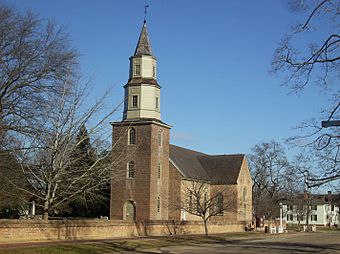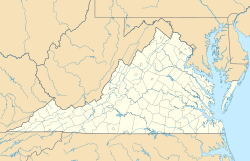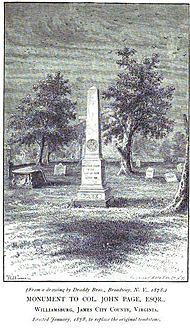Bruton Parish Church facts for kids
|
Bruton Parish Church
|
|

Bruton Parish Church from Duke of Gloucester Street
|
|
| Location | Williamsburg, Virginia |
|---|---|
| Area | C.H.A. |
| Built | 1677 |
| Architect | Alexander Spotswood |
| Architectural style | Georgian |
| Website | http://www.brutonparish.org/ |
| NRHP reference No. | 70000861 |
Quick facts for kids Significant dates |
|
| Added to NRHP | May 10, 1970 |
| Designated NHL | April 15, 1970 |
Bruton Parish Church is a historic church located in Colonial Williamsburg, Williamsburg, Virginia. It was started in 1674 when two older church areas (parishes) in the Virginia Colony joined together. Today, it is still an active Episcopal church. The church building, built between 1711 and 1715, was named a National Historic Landmark in 1970. It is a great example of early American colonial church design.
History of Bruton Parish Church
The story of Bruton Parish Church begins with the Church of England and the first English settlement in Jamestown in the early 1600s. In those days, the church and the government worked very closely together, just like they did in England.
The Church in Early Virginia (1607)
When the English colonists arrived in Jamestown on May 14, 1607, building a simple chapel and holding church services were top priorities. The first chaplain was Reverend Robert Hunt. He led the first prayers when the settlers landed near the Chesapeake Bay on April 29, 1607. He also placed a cross at Cape Henry.
Captain John Smith called Reverend Hunt our honest, religious and courageous divine. Hunt was a peacemaker among the colonists. Sadly, he did not survive the first difficult year. After many challenges, the colony began to grow. Just like in England, the church parish became an important local unit, similar to courts or the government assembly.
Early settlements were mostly along big rivers like the James River and the York River. As the colony grew, new church parishes and counties were created. Parishes needed to be close enough for people to travel to church, which everyone was expected to do. A parish was led by a rector (a priest) and managed by a group of respected community members called the vestry.
Middle Plantation Grows (1632)
The middle part of the Virginia Peninsula was settled starting in the 1630s. A wooden fence (stockade) was built across the peninsula between Archer's Hope Creek and Queen's Creek.
Dr. John Potts was important in this early development. He was a member of the Governor's Council and even served as Governor from 1629 to 1630. Dr. Potts owned a large farm called "Harrop."
In 1632, Dr. Potts received land for 1,200 acres (4.9 km2) at Archer's Hope Creek. Part of this land became the fortified palisade. A settlement called Middle Plantation was built on the ridge between the creeks. This area was owned by Colonel John Page.
Colonel John Page was a wealthy landowner and a member of the Virginia government. He gave land and money for the first brick Bruton Parish Church. He also helped bring the College of William & Mary to the area and donated more land for the town that became Williamsburg.
Middle Plantation was a good place to live because it was well-drained, meaning fewer mosquitoes. It was also easy to defend because of deep valleys and the main road running through it. This road later became Duke of Gloucester Street.
Middle Plantation Becomes a Town
Even with its good location, Middle Plantation did not become a big town right away. It was still a frontier area and faced attacks from Native Americans. After a major conflict in 1644, peace was made, and the area became safer.
By the 1650s, Middle Plantation started to look wealthy and populated. It was located on the border between James City County and York County. Colonel John Page, who moved from England in 1650, helped build Middle Plantation into a significant town. He built a large brick house, which showed wealth and permanence. Other important families, like the Ludwells, also built fine brick homes.
Church Services in Middle Plantation
In 1633, Middle Plantation Parish was created. There was a wooden church by about 1660. In 1658, Middle Plantation Parish joined with Harrop Parish to form Middletown Parish.
Bruton Parish was formed in 1674 when Marston Parish and Middletown Parish merged. The name "Bruton" comes from a town in England called Bruton, which was the hometown of several important colonial leaders. Bruton Parish was about 10 miles (16 km) square.
Colonel Page donated land and money for a new brick church in 1678. In return, his family was allowed to have a special seating area at the front of the church. Construction began in 1681 and was finished by November 29, 1683. The first rector, Reverend Rowland Jones, dedicated the church on January 6, 1684.
The first brick church, completed in 1683, was about 60 feet (18 m) long and 24 feet (7.3 m) wide. Its foundations are still buried near the current church building.
A New Role for the Church
Jamestown had problems as the capital, so the government often met in Middle Plantation. This, along with another event, made Middle Plantation and Bruton Parish very important.
In 1691, the Virginia government sent Reverend James Blair to England. He was the colony's top religious leader. His mission was to get a special document (charter) to start "a certain Place of Universal Study, a perpetual College..." Blair was successful with help from friends.
The College of William & Mary was founded on February 8, 1693. It was named after the ruling monarchs, King William III and Queen Mary II. It was one of the first colleges in America and was an Anglican institution.
Reverend Blair chose a site for the new college on the edge of Middle Plantation. He bought 330 acres (1.3 km2) of land for the school. The first main college building, the Wren Building, was started in 1695 and used by 1700. Today, it is the oldest academic building in America still in use.
In 1698, the State House in Jamestown burned down again. The government moved to Middle Plantation temporarily. On May 1, 1699, Reverend Blair and students from the college suggested that Middle Plantation become the new capital of Virginia. A month later, the government agreed. Middle Plantation was soon renamed Williamsburg in honor of King William III.
With Williamsburg as the new capital, a capitol building was planned, and the city was laid out. Bruton Parish Church had a very important spot in this new plan. Because it was the capital, government officials and college students attended Bruton Parish Church. The small church quickly became too crowded.
A New Church Building (1715)
Historians believe the church's location was central to Williamsburg's original design. However, the old brick church was in poor condition and too small.
In 1706, the church leaders decided to build a larger church. Since the local families could only afford a small one, they asked the colonial government for help. Four years later, the General Assembly agreed to pay for special seating areas (pews) for the governor, council, and government members. Royal Governor Alexander Spotswood designed the new church. It would be a cross-shaped building, 75 feet (23 m) long, 28 feet (8.5 m) wide, with 19-foot (5.8 m) long side wings.
Under the guidance of Dr. James Blair, who was rector from 1710 to 1743, construction began in 1711. The church was finished in 1715. It soon had all the necessary items like a Bible, prayer books, an altar, and a bell.
In 1755, the church got its first organ. Peter Pelham was chosen as the first organist.
American Revolution and Changes
When the American Revolutionary War started in 1776, people began to question the power of the king and the government's control over the church. Many important Virginia leaders, including Thomas Jefferson, George Washington, Patrick Henry, and George Mason, attended Bruton Parish Church.
In 1781, the capital moved to Richmond for safety during the war. After the new Constitution of the United States and the Bill of Rights were adopted, the ideas of Separation of Church and State and Freedom of Religion changed the church's role. Bruton Parish Church, like Williamsburg itself, saw a decline.
However, the church grew again as part of the Episcopal Church in the United States of America. In Virginia, people attended Bruton Parish Church by choice, and it has remained active to this day. Over the years, some changes were made to the church's inside, like moving the altar. In the early 1900s, an important restoration took place.
Bringing Colonial Williamsburg Back to Life
The revitalization of Bruton Parish Church was largely due to its rector, Reverend Dr. W.A.R. Goodwin (1869–1939), who arrived in 1903. He was inspired by the church's history and the many surviving 18th-century buildings. Dr. Goodwin raised money and oversaw the restoration of the old church building. The church's interior was restored to its colonial look by 1907, just in time for the 300th anniversary of the Episcopal Church in America. This work was just the beginning of a much larger restoration project.
Dr. Goodwin later returned to Bruton Parish in 1923. He was worried about other historic buildings in Williamsburg that were falling apart. In 1924, he started a movement to save them. He was very lucky to get help from John D. Rockefeller Jr., the wealthy son of the founder of Standard Oil, and his wife Abby Aldrich Rockefeller. They became very interested in the old city and provided the money to restore it. Together, the Rockefellers and Dr. Goodwin made the amazing dream of restoring the old colonial capital come true.
The Search for "Bacon's Vault"
In 1938, a woman named Marie Bauer claimed to have found a secret message in an old book. She believed it said that a hidden vault was under the first brick church at Bruton Parish. She thought this vault contained lost writings by Sir Francis Bacon, including proof that he wrote William Shakespeare's plays.
Bauer got permission to dig. Using clues she said she found on tombstones, she uncovered the foundations of the original 1683 church. The digging stopped at about nine feet deep because people worried about disturbing graves. Bauer then hired engineers who used metal detectors. They said there might be a large, partially filled space about 16 to 20 feet deep.
Interest in the vault returned in 1985 when radar tests showed possible disturbed ground. After some people were caught digging illegally, the Colonial Williamsburg Foundation started a new excavation in 1992. Archaeologists dug to twenty feet but found no vault. A geologist from the College of William & Mary took soil samples and concluded that the ground at that depth had not been disturbed for millions of years.
Bruton Parish Church Today
Today, Colonial Williamsburg's Historic Area covers 173 acres (70 ha). It includes 88 original buildings and more than 50 major reconstructions. It is connected by the Colonial Parkway to Jamestown and Yorktown. Jamestown was where England's first permanent colony in the Americas was established. Yorktown was where the American army, led by George Washington, won a key victory that ended British rule.
Bruton Parish Church is now a very active church in the Episcopal Diocese of Southern Virginia. It has almost two thousand members, four Sunday services, and active groups for youth and college students. The church has been restored to look like it did during the colonial era. Name plates on its special seating areas (box pews) remember famous people who worshipped there, including George Washington, Thomas Jefferson, and Patrick Henry.
The church still uses a bell made in 1761. This bell rang to celebrate the signing of the Declaration of Independence in 1776. It also rang for the signing of the Treaty of Paris in 1783, which ended the American Revolutionary War. The bell is engraved: "The Gift of James Tarpley to Bruton Parish, 1761."
Just as the church welcomed people from the new college and capital in the 1700s, it now welcomes visitors to Colonial Williamsburg. Locals, students, and community leaders still worship there.
Music Program
Bruton Parish Church has a long history of music, starting in 1755. In early times, only instrumental music before and after services, and responsive chanting of psalms, were allowed. However, the church had an organ since 1755, which was unusual for the time. Because it was in the capital city and had important members, the organ was considered necessary.
Peter Pelham was the first organist. He started the tradition of Candlelight Concerts. He would let locals come and listen while he taught music to talented students.
Today, the music program continues these traditions. There are two main choirs, the Pelham and Chancel choirs, which sing at morning services and special concerts. There is also a college student choir, two children's choirs, an orchestra, and a handbell choir. The church still holds candlelight concerts with guest choirs, organists, and musicians on Tuesday, Thursday, and Saturday nights. They also have special monthly Evensong services with guest choirs.
In 2011, the church created a new position called "organ scholar." This person studies the organ and performs at services and concerts. Allen T. Blehl was the first organ scholar. In 2014, Carina Sturdy became the new organ scholar.
See also









